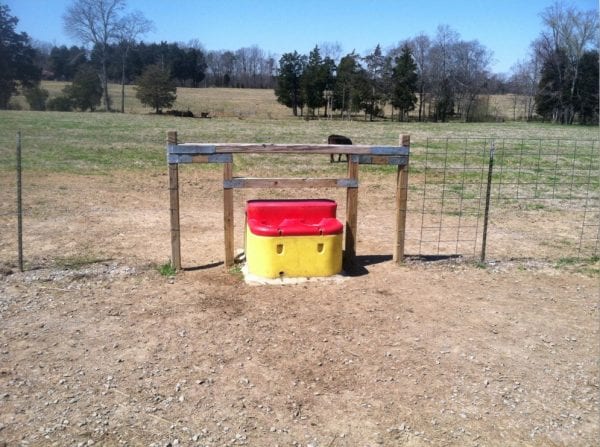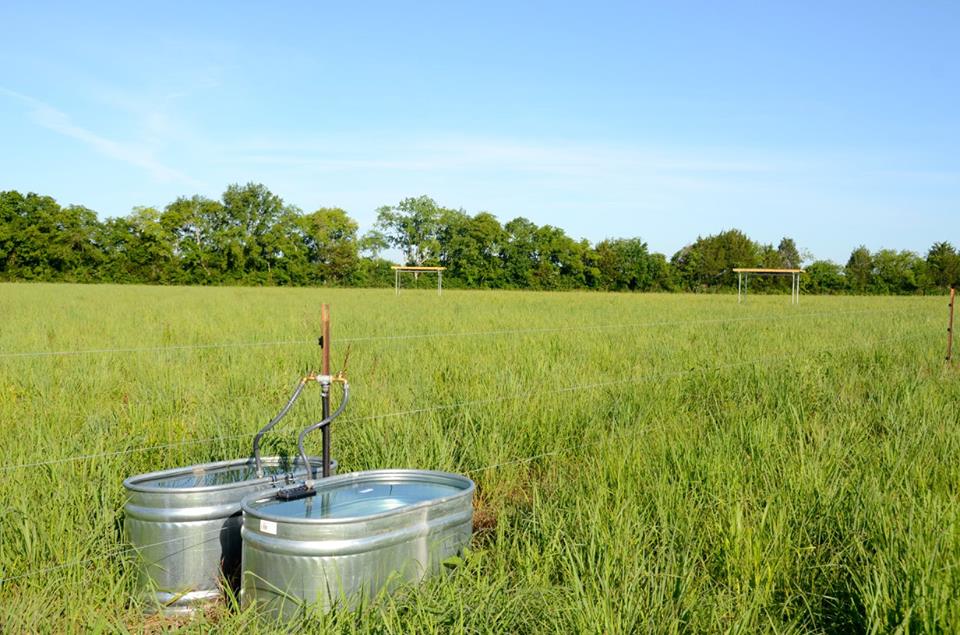Beef

The quantity and quality of water required by livestock are important considerations for the overall maintenance of herd health and productivity. If water is suspected of causing a health problem, seek veterinary assistance to determine a diagnosis.
Water Quantity and Quality
Cattle may drink from 7 to 30 gallons of water a day depending on factors such as season, forage (dry or green), and physiological state (age, weight, pregnancy, and lactation). A clean stock tank with high-quality water promotes healthy livestock. Nursing calves have a 9 percent higher weight gain when the drinking water for the cow-calf pairs comes from a trough compared to cattle drinking directly from a pond. Cattle prefer good tasting water—poor tasting water can influence forage intake, especially hay. Drinking more water can mean more efficient forage consumption and increased weight gain.
What Are the Concerns?
Keeping your stock tank clean can be a challenge in the summer, but it is important. Warm summer temperatures, abundant sunlight, and nutrients mix together in a water trough to create ideal conditions for algae growth.
Algae may create less desirable drinking water taste, and some types of algae can poison cattle. Nutrients from livestock slobber, urine or feces, and debris blowing into the tank can stimulate harmful algae growth, such as cyanobacteria or blue-green algae. Cattle can become sick from toxins (microcystins) released by blue-green algae.
Viruses, parasites, and bacteria may also thrive in tanks that are not properly cleaned and can lead to livestock health issues.
Getting Control and Cleaning
 Using rails to control and prevent livestock access to tanks can assist in keeping cattle from introducing nutrients. Make certain rails are positioned low enough so that a cow can’t slip under the rail. Controlling clogged overflows caused by algae can help avoid excess algae growth that produce toxins.
Using rails to control and prevent livestock access to tanks can assist in keeping cattle from introducing nutrients. Make certain rails are positioned low enough so that a cow can’t slip under the rail. Controlling clogged overflows caused by algae can help avoid excess algae growth that produce toxins.
Check the tank for water quality and foreign objects that may promote algae growth or be harmful to the cattle. The presence of leaves, urine, and feces are linked to increased algae growth. Water quality (pH, salinity, temperature) should be within recommendations.
For details on drinking water recommendations, see Extension publication ANR-2381, “Drinking Water for Livestock,” that may be downloaded from www.aces.edu.
Clean Tank Tips
Cleaning the trough periodically is a good idea. Most troughs should be drained and cleaned once a year or every 6 months if they get very dirty. Consider cleaning out troughs in the spring before hot summer temperatures arrive to keep them relatively clean through the summer. If needed, add 2 ounces of household chlorine bleach (unscented, 5.25 percent sodium hypochlorite) to 50 gallons of water weekly to help regulate algae growth. Other chemical control options include copper sulfate at the rate of 1⁄8 teaspoon per 100 gallons. Be sure to remove the dead algae from the tank after treatment.
Goldfish are also an option for algae control. Add 4 to 6 goldfish per 100 gallons of tank capacity and be aware that they survive best when the temperature is at least 60 degrees F. Add bricks, rocks, or some structure so the fish can hide from predators (birds, raccoons). Fish kills are a concern if the tank water level gets too low and there is not enough oxygen or in the winter when the water temperature is too cold or freezes.
What If the Tank Needs a Good Scrubbing?
- Add one part household chlorine bleach for 32 parts of water.
- Let the water sit for 15 minutes.
- Drain and scrub the tank wall.
- Keep livestock away from the tank for at least 30 minutes during cleaning.
Getting the tank empty can be difficult unless the tank has a built-in drain. If there isn’t a built-in drain, consider turning off the water and letting the livestock drink the water down to a point where it can be easily accessed.
Hello Sunshine
Keeping the troughs out of direct sunlight can also help minimize algae growth. Consider using temporary covers or placing tanks in the shade. Freeze-proof troughs, such as floating ball top waterers, work well in cold weather and keep water cool in the summer. They also keep water relatively clean and free of algae.
Take-Home Message
Spending a few minutes each week to scout out potential problems and perform routine cleaning can help keep livestock water tanks clean. Clean tanks and good quality water will promote healthy, productive herds.
Curious about your cattle’s drinking water quality? The Auburn University Soil, Forage, and Water Testing Laboratory can screen water samples for 16 parameters of interest including nitrates, pH, and total dissolved solids. If water is suspected of causing a health problem, veterinary assistance should be sought to determine the actual health problem. The lab is located in the ALFA Building, 961 S. Donahue Drive, Auburn University, AL 36849-5411. Phone number is (334) 844-3958.
 Eve Brantley, Extension Specialist, Professor, Crop, Soil, and Environmental Sciences; Kim Mullenix, Extension Specialist, Assistant Professor, Animal Sciences and Forages: Landon Marks, Regional Extension Agent, Animal Sciences and Forages; and Kent Stanford, Extension Specialist, Animal Sciences and Forages, all with Auburn University
Eve Brantley, Extension Specialist, Professor, Crop, Soil, and Environmental Sciences; Kim Mullenix, Extension Specialist, Assistant Professor, Animal Sciences and Forages: Landon Marks, Regional Extension Agent, Animal Sciences and Forages; and Kent Stanford, Extension Specialist, Animal Sciences and Forages, all with Auburn University
Reviewed July 2021, Keeping It Clean: Livestock Water Tank Maintenance, ANR-2583

